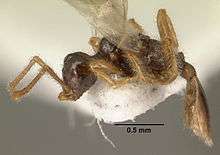Tetramorium inquilinum
| Tetramorium inquilinum | |
|---|---|
 | |
| T. inquilinum alate queen from France | |
| Scientific classification | |
| Kingdom: | Animalia |
| Phylum: | Arthropoda |
| Class: | Insecta |
| Order: | Hymenoptera |
| Family: | Formicidae |
| Subfamily: | Myrmicinae |
| Tribe: | Tetramoriini |
| Genus: | Tetramorium |
| Species: | T. inquilinum |
| Binomial name | |
| Tetramorium inquilinum Ward, Brady, Fisher & Schultz, 2014 | |
| Synonyms | |
|
Teleutomyrmex schneideri (Klutter, 1950) | |
Tetramorium inquilinum is an ectoparasitic ant found in the France and Switzerland. It was discovered by Swiss myrmecologist Heinrich Kutter.[1] The species is unusual for lacking a worker caste, the queens and males living entirely off the care of the pavement ant.[2]
Morphology
The body shape of Tetramorium inquilinum is specifically adapted. The queens average 2.5 mm in length, and have a concave form and large pads and claws. Tetramorium inquilinum is frail and unable to care for itself, with mandibles too small and weak to handle anything but liquid food, sting and poison glands small, and glands that produce food for larvae and protection against bacteria are completely absent. Its exoskeleton is thin and its brain and central nerve cord are small and simplified.
Behavior
Tetramorium inquilinum constantly sends chemical signals that trick host ants into accepting them as full members of the colony. Being ectoparasitic, Tetramorium inquilinum spends most of its adult life clinging to the backs of its hosts, especially queens. As many as eight have been observed piggy-backing onto a single host queen, leaving her immobile.[1]
Diet
Tetramorium inquilinum lives entirely on food regurgitated by its hosts, even the liquid meant for the host queen.[1]
Reproduction
Nourished and nurtured well by its hosts, Tetramorium inquilinum has high fecundity. Older individuals lay an average of two eggs every minute.[1]
References
Further reading
- Kutter, Heinrich (1969), Die Sozialparasitischen Ameisen der Schweiz
External links
 Media related to Tetramorium inquilinum at Wikimedia Commons
Media related to Tetramorium inquilinum at Wikimedia Commons- Social Insects Specialist Group 1996. Teleutomyrmex schneideri. 2006 IUCN Red List of Threatened Species. Downloaded on 10 August 2007.
- Buschinger, Alfred. Teleutomyrmex schneideri Kutter 1950 and other parasitic ants found in the Pyrenees (Hymenoptera, Formicidae). (1987). Internet Archive. Retrieved 10 August 2012.
